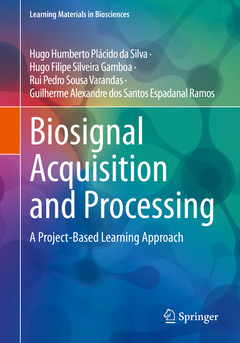Description
Biosignal Acquisition and Processing, 1st ed. 2024
A Project-Based Learning Approach
Learning Materials in Biosciences Series
Authors: da Silva Hugo Humberto Plácido, Silveira Gamboa Hugo Filipe, Sousa Varandas Rui Pedro, dos Santos Espadanal Ramos Guilherme Alexandre
Language: English
Subjects for Biosignal Acquisition and Processing:
Keywords
biosignals data acquisition device; data acquisition device; data transmission; biosignal Arduino computer dialogues; arduino computer; Barebone data acquisition system; biosignal APIs; Online signal processing; reaction time meter; Electromyographic (EMG) onset detection; biosignal data logger; biosignal plotting real time; biosignal live streaming
73.84 €
In Print (Delivery period: 15 days).
Add to cart344 p. · 16.8x24 cm · Paperback
Description
/li>Contents
/li>Biography
/li>Comment
/li>
This textbook provides an introduction to common concepts in biosignal acquisition and processing, rooted in a Project-Based Learning (PBL). A series of exercises and corresponding solutions is described, with a focus on common problems that new entrants encounter in the undergraduate and graduate curriculums in biomedical engineering, psychophysiology, human-computer interaction, physiotherapy, and others developing work in the boundary between biosignal acquisition and other disciplines. Solutions include both hardware and software components, encompassing sensor design, biosignals acquisition using the Arduino and BITalino platforms, Python for signal processing, analysis, and knowledge extraction, including also HTML/CSS/JavaScript for user interface design. All the content is supported with rich graphics, source code, and other useful resources made available to the interested reader. This is an ideal book for undergraduate students and practitioners (across disciplines) who are studying or working in the field of biomedical signal acquisition, processing, and analysis.
Chapter 1. Meet your Biosignals.- Chapter 2. Biosignals Sensor Creation.- Chapter 3. Arduino Essentials.- Chapter 4. Analog Signals.- Chapter 5. Data Transmission.- Chapter 6. Sampling.- Chapter 7. Live Streaming.-Chapter 8. Basic Primer on APIs.- Chapter 9. Real-time Analytics.- Chapter 10. Essentials of Data Processing.- Chapter 11. Working with Features.- Chapter 12. Frequency Domain.- Chapter 13. Signal Modulation.- Chapter 14. Machine Learning.- Chapter 15. Machine Learning Strikes Back.- Chapter 16. File Exploration.- Chapter 17. From Python to the World.- Chapter 18. Interchanging Data.- Chapter 19. Into the World Wild Web.- Chapter 20. Jazzing Up Your UIs.-Chapter 21. Tame Your Pages.
Hugo Humberto Plácido da Silva is a biomedical researcher, inventor and entrepreneur, holding a PhD in electrical and computers engineering from Instituto Superior Técnico (IST) – University of Lisbon (UL). He is a Senior Researcher at Instituto de Telecomunicações (IT), where he works since 2004, and a Professor at the Department of Bioengineering (DBE) of IST-UL since 2019. He is also co-founder and Chief Innovation Officer of PLUX – Wireless Biosignals, S.A., established in 2007 as an innovative technology-based company operating in the field of medical devices for healthcare and quality of life. In the scope of these assignments, his work has been widely recognized both domestically and internationally. His current interests include biosignal acquisition, biomedical instrumentation, system engineering, signal processing, and machine learning, areas in which he holds 7 patents and has performed pioneering theoretical, methodological, and technical contributions.
Hugo Filipe Silveira Gamboais an Associate Professor at the Physics Department of Nova School of Science and Technology from Nova University Lisbon and member of the LIBPHYS-UNL research center. He is co-founder and president of PLUX, a technology-based innovative company in the field of systems and wireless medical sensors, where he supports the company research vision of a multidisciplinary team, that covers microelectronics, biosignal processing and software development.
Rui Pedro Sousa Varandas is a PhD student currently enrolled at Nova School of Science and Technology from Nova University Lisbon, where he also completed his Master's degree in Biomedical Engineering. His research is focused on studying the possibility of monitoring learning states through biosignals and human-computer interaction variables, and he is working in collaboration with LIBPhys-UNL and PLUX - Wireless Biosignals, S.A.
Guilherme Alexandre dos Santos Espadanal Ramos wor
Covers the basics of biosignals, from setting up a data acquisition device to basic biomechanics
Follows a strong Project-Based Learning (PBL) approach
Provides many exercises and proposed solutions so students can better comprehend the underpinnings of common concepts




